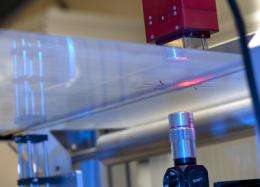Siemens researchers have developed the world’s fastest LED stroboscopic lamp for the purposes of quality control.
This high-power light source makes very short exposure times possible and can therefore be used to capture high-resolution images of fast-moving objects. This makes it ideal for monitoring rapid production processes. The high-speed flash unit has been developed for an inspection system for printed electronics. Compared to the halogen lamps conventionally used, it not only consumes less energy but also heats up the inspection area to lesser degree.
Quality control often involves the use of optical procedures, whereby a camera is used to record digital images for subsequent analysis. Production processes are often so fast that conventional camera systems are incapable of delivering a sharp image. In this case, tests are deferred until the end of manufacturing and carried out on individual production units. If a fault is discovered, all the units produced after the last test have to be rejected. In order to conduct in-line testing, during the actual production process, exposure times of well under one millionth of a second are required. A light source of such speed and with sufficient power has not yet been developed. The only alternative is to use a continuous light and a camera with extremely fast shutter speeds. This is relatively expensive, however, and also has the disadvantage that the light source heats up the inspection area.
The new high-speed, high-power light source developed by researchers at Siemens Corporate Technology (CT) comprises a number of LEDs. It enables exposure times of 0.3 millionth of a second (300 nanoseconds) — much faster than conventional photoflash units (50 microseconds) and industrial stroboscope lamps (one microsecond). Moreover, the power of the LED flash can be very finely adjusted to a value of over 12 kilowatts. The flash unit combines LEDs of different wavelengths, so the color of the light can be adjusted to the product being inspected.
The flash unit was developed as part of the MaDriX project, which is funded by the German Ministry of Education and Research. It is suitable for a whole range of applications at Siemens and other companies, where it will help to enhance production processes and reduce inspection and energy costs.
Source: Siemens



















